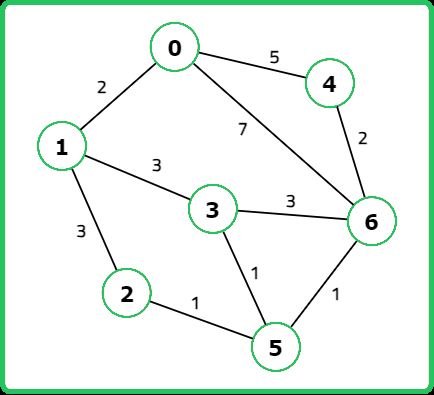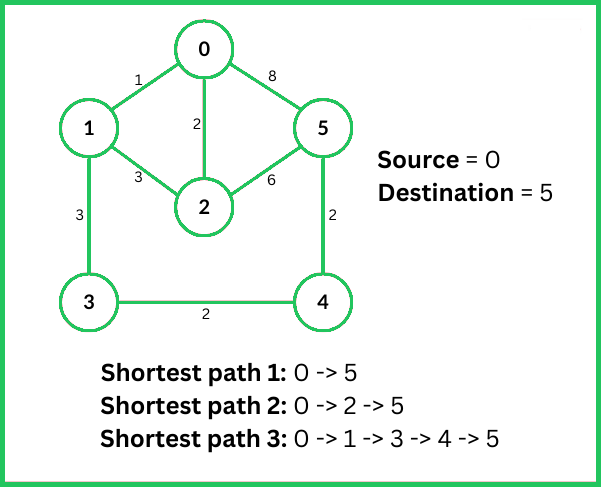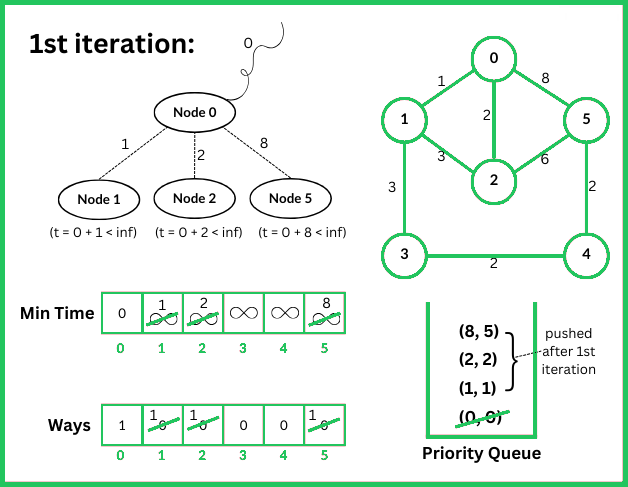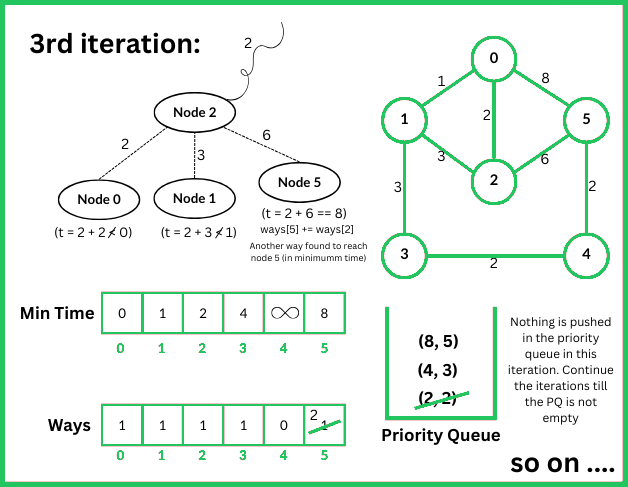123456789101112131415161718192021222324252627282930313233343536373839404142434445464748495051525354555657585960616263646566676869707172737475767778798081828384858687888990919293949596979899100101102103104105106107108109
#include <bits/stdc++.h>
using namespace std;
/* Define P as a shorthand for
the pair<long long,int> type */
#define P pair<long long,int>
class Solution {
public:
/* Function to get the number of ways to arrive
at destinations in shortest possible time */
int countPaths(int n, vector<vector<int>>& roads) {
int mod = 1e9 + 7; // Mod value
// To store the graph
vector<pair<int,int>> adj[n];
// Adding the edges to the graph
for(auto it : roads) {
adj[it[0]].push_back({it[1] , it[2]});
adj[it[1]].push_back({it[0] , it[2]});
}
/* Array to store the minimum
time to get to nodes */
vector<long long> minTime(n, LLONG_MAX);
/* To store the number of
ways to reach nodes */
vector<int> ways(n, 0);
// Priority queue to store: {time, node}
priority_queue <P, vector<P>, greater<P>> pq;
//Initial configuration
minTime[0] = 0;
ways[0] = 1;
pq.push({0, 0});
// Until the priority queue is empty
while(!pq.empty()) {
// Get the element
auto p = pq.top();
pq.pop();
long long time = p.first; // time
int node = p.second; // node
// Traverse its neighbors
for(auto it : adj[node]) {
int adjNode = it.first; // adjacent node
int travelTime = it.second; // travel time
/* If the current time taken is less than
earlier known time to reach adjacent node */
if(minTime[adjNode] > time + travelTime) {
// Update the time to reach adjacent node
minTime[adjNode] = time + travelTime;
// Update the number of ways
ways[adjNode] = ways[node];
// Add the new element in priority queue
pq.push({minTime[adjNode] , adjNode});
}
/* Else if the current time taken is same as
earlier known time to reach adjacent node */
else if(minTime[adjNode] == time + travelTime) {
/* Update the number of ways
to reach adjacent nodes */
ways[adjNode] = (ways[adjNode] + ways[node]) % mod;
}
}
}
// Return the result
return ways[n-1] % mod;
}
};
int main() {
int n = 7, m = 20;
vector<vector<int>> roads = {
{0,6,7},{0,1,2},{1,2,3},
{1,3,3},{6,3,3},{3,5,1},
{6,5,1},{2,5,1},{0,4,5},
{4,6,2}
};
/* Creating an instance of
Solution class */
Solution sol;
/* Function call to get the number of ways to
arrive at destinations in shortest possible time */
int ans = sol.countPaths(n, roads);
// Output
cout << "The number of ways to arrive at destinations in shortest possible time is: " << ans;
return 0;
}
123456789101112131415161718192021222324252627282930313233343536373839404142434445464748495051525354555657585960616263646566676869707172737475767778798081828384858687888990919293949596979899100101102103104105106107108109110111
import java.util.*;
class Solution {
/* Function to get the number of ways to arrive
at destinations in shortest possible time */
public int countPaths(int n, List<List<Integer>> roads) {
int mod = 1000000007; // Mod value
// To store the graph
List<int[]>[] adj = new ArrayList[n];
for (int i = 0; i < n; i++) {
adj[i] = new ArrayList<>();
}
// Adding the edges to the graph
for (List<Integer> it : roads) {
adj[it.get(0)].add(new int[]{it.get(1), it.get(2)});
adj[it.get(1)].add(new int[]{it.get(0), it.get(2)});
}
/* Array to store the minimum
time to get to nodes */
long[] minTime = new long[n];
Arrays.fill(minTime, Long.MAX_VALUE);
/* To store the number of
ways to reach nodes */
int[] ways = new int[n];
// Priority queue to store: {time, node}
PriorityQueue<long[]> pq =
new PriorityQueue<>(Comparator.comparingLong(a -> a[0]));
// Initial configuration
minTime[0] = 0;
ways[0] = 1;
pq.add(new long[]{0, 0});
// Until the priority queue is empty
while (!pq.isEmpty()) {
// Get the element
long[] p = pq.poll();
long time = p[0]; // time
int node = (int) p[1]; // node
// Traverse its neighbors
for (int[] it : adj[node]) {
int adjNode = it[0]; // adjacent node
int travelTime = it[1]; // travel time
/* If the current time taken is less than
earlier known time to reach adjacent node */
if (minTime[adjNode] > time + travelTime) {
// Update the time to reach adjacent node
minTime[adjNode] = time + travelTime;
// Update the number of ways
ways[adjNode] = ways[node];
// Add the new element in priority queue
pq.add(new long[]{minTime[adjNode], adjNode});
}
/* Else if the current time taken is same as
earlier known time to reach adjacent node */
else if (minTime[adjNode] == time + travelTime) {
/* Update the number of ways
to reach adjacent nodes */
ways[adjNode] = (ways[adjNode] + ways[node]) % mod;
}
}
}
// Return the result
return ways[n - 1] % mod;
}
public static void main(String[] args) {
int n = 7, m = 20;
List<List<Integer>> roads = Arrays.asList(
Arrays.asList(0, 6, 7),
Arrays.asList(0, 1, 2),
Arrays.asList(1, 2, 3),
Arrays.asList(1, 3, 3),
Arrays.asList(6, 3, 3),
Arrays.asList(3, 5, 1),
Arrays.asList(6, 5, 1),
Arrays.asList(2, 5, 1),
Arrays.asList(0, 4, 5),
Arrays.asList(4, 6, 2)
);
/* Creating an instance of
Solution class */
Solution sol = new Solution();
/* Function call to get the number of ways to
arrive at destinations in shortest possible time */
int ans = sol.countPaths(n, roads);
// Output
System.out.println("The number of ways to arrive at destinations in shortest possible time is: " + ans);
}
}
123456789101112131415161718192021222324252627282930313233343536373839404142434445464748495051525354555657585960616263646566676869707172737475767778798081828384858687888990
import heapq
from collections import defaultdict
from typing import List
class Solution:
# Function to get the number of ways to arrive
# at destinations in shortest possible time
def countPaths(self, n: int, roads: List[List[int]]) -> int:
mod = 10**9 + 7 # Mod value
# To store the graph
adj = defaultdict(list)
# Adding the edges to the graph
for it in roads:
adj[it[0]].append((it[1], it[2]))
adj[it[1]].append((it[0], it[2]))
# Array to store the minimum
# time to get to nodes
minTime = [float('inf')] * n
# To store the number of
# ways to reach nodes
ways = [0] * n
# Priority queue to store: {time, node}
pq = []
# Initial configuration
minTime[0] = 0
ways[0] = 1
heapq.heappush(pq, (0, 0))
# Until the priority queue is empty
while pq:
# Get the element
time, node = heapq.heappop(pq)
# Traverse its neighbors
for adjNode, travelTime in adj[node]:
# If the current time taken is less than
# earlier known time to reach adjacent node
if minTime[adjNode] > time + travelTime:
# Update the time to reach adjacent node
minTime[adjNode] = time + travelTime
# Update the number of ways
ways[adjNode] = ways[node]
# Add the new element in priority queue
heapq.heappush(pq, (minTime[adjNode], adjNode))
# Else if the current time taken is same as
# earlier known time to reach adjacent node
elif minTime[adjNode] == time + travelTime:
# Update the number of ways
# to reach adjacent nodes
ways[adjNode] = (ways[adjNode] + ways[node]) % mod
# Return the result
return ways[n - 1] % mod
# Example usage
if __name__ == "__main__":
n = 7
roads = [
[0, 6, 7], [0, 1, 2], [1, 2, 3],
[1, 3, 3], [6, 3, 3], [3, 5, 1],
[6, 5, 1], [2, 5, 1], [0, 4, 5],
[4, 6, 2]
]
# Creating an instance of
# Solution class
sol = Solution()
# Function call to get the number of ways to
# arrive at destinations in shortest possible time
ans = sol.countPaths(n, roads)
# Output
print("The number of ways to arrive at destinations in shortest possible time is:", ans)
123456789101112131415161718192021222324252627282930313233343536373839404142434445464748495051525354555657585960616263646566676869707172737475767778798081828384858687888990919293949596979899100101102103104105106107108109110111112113114115116117118119120121122123124125126127128129130131132133134135136137138139140141142143144145146147148149150151152153154155156157158159160161162163164165
// Class implementation Min heap
class MinPriorityQueue {
constructor() {
this.heap = [];
}
isEmpty() {
return this.heap.length === 0;
}
enqueue(element) {
this.heap.push(element);
this.bubbleUp();
}
dequeue() {
if (this.heap.length === 1) {
return this.heap.pop();
}
const top = this.heap[0];
this.heap[0] = this.heap.pop();
this.bubbleDown();
return top;
}
bubbleUp() {
let index = this.heap.length - 1;
const element = this.heap[index];
while (index > 0) {
const parentIndex = Math.floor((index - 1) / 2);
const parent = this.heap[parentIndex];
if (element[0] >= parent[0]) break;
this.heap[index] = parent;
index = parentIndex;
}
this.heap[index] = element;
}
bubbleDown() {
let index = 0;
const length = this.heap.length;
const element = this.heap[index];
while (true) {
let leftChildIndex = 2 * index + 1;
let rightChildIndex = 2 * index + 2;
let leftChild, rightChild;
let swapIndex = null;
if (leftChildIndex < length) {
leftChild = this.heap[leftChildIndex];
if (leftChild[0] < element[0]) {
swapIndex = leftChildIndex;
}
}
if (rightChildIndex < length) {
rightChild = this.heap[rightChildIndex];
if (
(swapIndex === null && rightChild[0] < element[0]) ||
(swapIndex !== null && rightChild[0] < leftChild[0])
) {
swapIndex = rightChildIndex;
}
}
if (swapIndex === null) break;
this.heap[index] = this.heap[swapIndex];
index = swapIndex;
}
this.heap[index] = element;
}
}
class Solution {
/* Function to get the number of ways to arrive
at destinations in shortest possible time */
countPaths(n, roads) {
const mod = 1e9 + 7; // Mod value
// To store the graph
const adj = Array.from({ length: n }, () => []);
// Adding the edges to the graph
for (const it of roads) {
adj[it[0]].push([it[1], it[2]]);
adj[it[1]].push([it[0], it[2]]);
}
/* Array to store the minimum
time to get to nodes */
const minTime = Array(n).fill(Infinity);
/* To store the number of
ways to reach nodes */
const ways = Array(n).fill(0);
// Priority queue to store: {time, node}
const pq = new MinPriorityQueue();
// Initial configuration
minTime[0] = 0;
ways[0] = 1;
pq.enqueue([0, 0]);
// Until the priority queue is empty
while (!pq.isEmpty()) {
// Get the element
const [time, node] = pq.dequeue();
// Traverse its neighbors
for (const [adjNode, travelTime] of adj[node]) {
/* If the current time taken is less than
earlier known time to reach adjacent node */
if (minTime[adjNode] > time + travelTime) {
// Update the time to reach adjacent node
minTime[adjNode] = time + travelTime;
// Update the number of ways
ways[adjNode] = ways[node];
// Add the new element in priority queue
pq.enqueue([minTime[adjNode], adjNode]);
}
/* Else if the current time taken is same as
earlier known time to reach adjacent node */
else if (minTime[adjNode] === time + travelTime) {
/* Update the number of ways
to reach adjacent nodes */
ways[adjNode] = (ways[adjNode] + ways[node]) % mod;
}
}
}
// Return the result
return ways[n - 1] % mod;
}
}
// Example usage
const n = 7;
const roads = [
[0, 6, 7], [0, 1, 2], [1, 2, 3],
[1, 3, 3], [6, 3, 3], [3, 5, 1],
[6, 5, 1], [2, 5, 1], [0, 4, 5],
[4, 6, 2]
];
/* Creating an instance of
Solution class */
const sol = new Solution();
/* Function call to get the number of ways to
arrive at destinations in shortest possible time */
const ans = sol.countPaths(n, roads);
// Output
console.log("The number of ways to arrive at destinations in shortest possible time is: " + ans);


 which represents that there are three shortest paths to reach the destination node from the source node.
which represents that there are three shortest paths to reach the destination node from the source node. 


